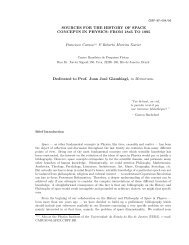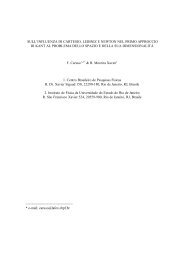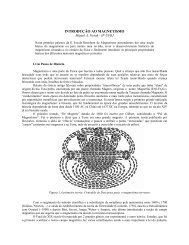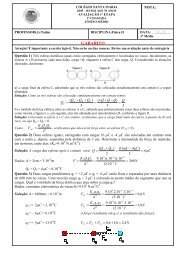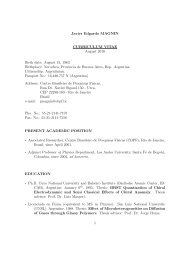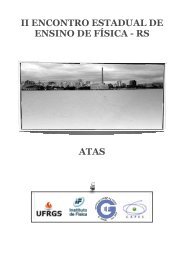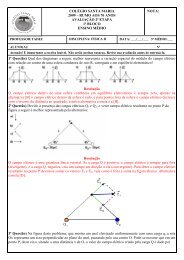Primordial non-Gaussianity in the cosmological perturbations - CBPF
Primordial non-Gaussianity in the cosmological perturbations - CBPF
Primordial non-Gaussianity in the cosmological perturbations - CBPF
Create successful ePaper yourself
Turn your PDF publications into a flip-book with our unique Google optimized e-Paper software.
1.4 The <strong>cosmological</strong> redshift<br />
Without explicitly solv<strong>in</strong>g E<strong>in</strong>ste<strong>in</strong>’s equations for <strong>the</strong> dynamics of <strong>the</strong> expansion, it is still possible<br />
to understand many of <strong>the</strong> k<strong>in</strong>ematic effects of <strong>the</strong> expansion upon light from distant galaxies. The<br />
light emitted by a distant object can be viewed quantum mechanically as freely-propagat<strong>in</strong>g photons,<br />
or classically as propagat<strong>in</strong>g plane waves. In <strong>the</strong> quantum mechanical description, <strong>the</strong> wavelength<br />
of light is <strong>in</strong>- <strong>in</strong>versely proportional to <strong>the</strong> photon momentum λ = h/p. If <strong>the</strong> momentum changes,<br />
<strong>the</strong> wavelength of <strong>the</strong> light must change. It was shown <strong>in</strong> <strong>the</strong> previous section that <strong>the</strong> momentum<br />
of a photon changes <strong>in</strong> proportion to a −1 . S<strong>in</strong>ce <strong>the</strong> wavelength of a photon is <strong>in</strong>versely proportional<br />
to its momentum, <strong>the</strong> wavelength at time t0, denoted as λ0, will differ from that at time t1, denoted<br />
as λ1, by<br />
λ1<br />
λ0<br />
= a(t1)<br />
. (33)<br />
a(t0)<br />
As <strong>the</strong> universe expands, <strong>the</strong> wavelength of a freely-propagat<strong>in</strong>g photon <strong>in</strong>creases, just as all physical<br />
distances <strong>in</strong>crease with <strong>the</strong> expansion. This means that <strong>the</strong> red shift of <strong>the</strong> wavelength of a photon<br />
is due to <strong>the</strong> fact that <strong>the</strong> universe was smaller when <strong>the</strong> photon was emitted.<br />
It is also possible to derive <strong>the</strong> same result by consider<strong>in</strong>g <strong>the</strong> propagation of light from a distant<br />
galaxy as a classical wave phenome<strong>non</strong>. Let us aga<strong>in</strong> place ourselves at <strong>the</strong> orig<strong>in</strong> r = 0. We consider<br />
a radially travell<strong>in</strong>g electro-magnetic wave (a light ray) and consider <strong>the</strong> equation ds 2 = 0 or<br />
dt 2 = a 2 (t) dr2<br />
. (34)<br />
1 − kr2 Let us assume that <strong>the</strong> wave leaves a galaxy located at r at time t. Then it will reach us at time t0<br />
given by<br />
t0<br />
t<br />
r<br />
dt<br />
= f(r) =<br />
a(t) 0<br />
dr<br />
√ 1 − kr 2 =<br />
⎧<br />
⎪⎨<br />
⎪⎩<br />
s<strong>in</strong> −1 r = r + r 3 /6 + · · · (k = +1),<br />
r (k = 0),<br />
s<strong>in</strong>h −1 r = r − r 3 /6 + · · · (k = −1).<br />
As typical galaxies will have constant coord<strong>in</strong>ates, f(r) (which can of course be given explicitly, but<br />
this is not needed for <strong>the</strong> present analysis) is time-<strong>in</strong>dependent. If <strong>the</strong> next wave crest leaves <strong>the</strong><br />
galaxy at r at time (t + δt), it will arrive at time (t0 + δt0) given by<br />
r<br />
f(r) =<br />
0<br />
dr<br />
√<br />
1 − kr2 =<br />
t0+δt0<br />
t+δt<br />
(35)<br />
dt<br />
. (36)<br />
a(t)<br />
Subtract<strong>in</strong>g <strong>the</strong>se two equations and mak<strong>in</strong>g <strong>the</strong> (em<strong>in</strong>ently reasonable) assumption that <strong>the</strong> cosmic<br />
scale factor a(t) does not vary significantly over <strong>the</strong> period δt given by <strong>the</strong> frequency of light, we<br />
obta<strong>in</strong><br />
16




